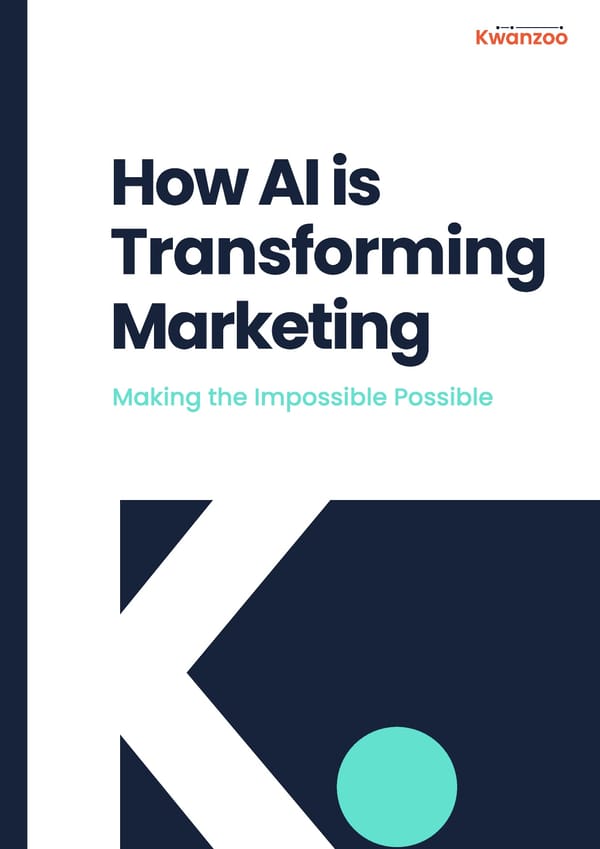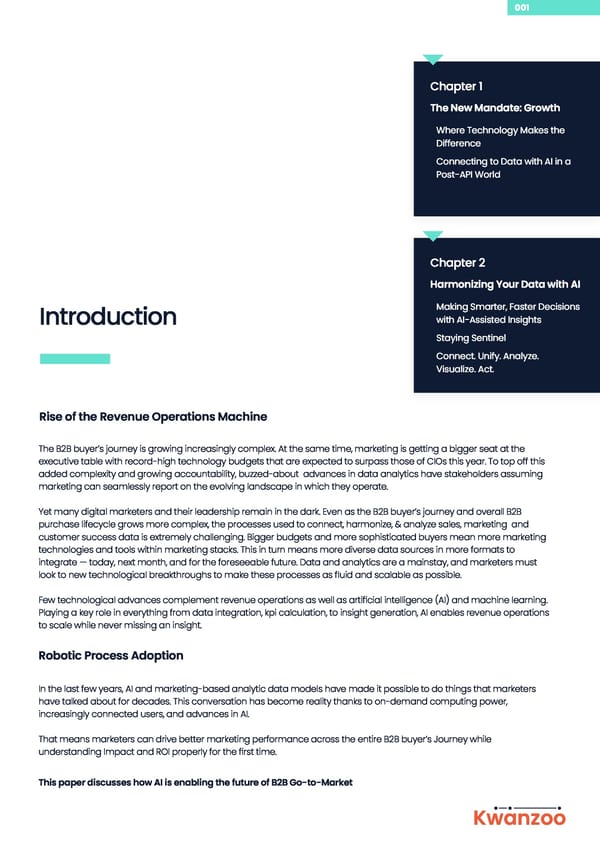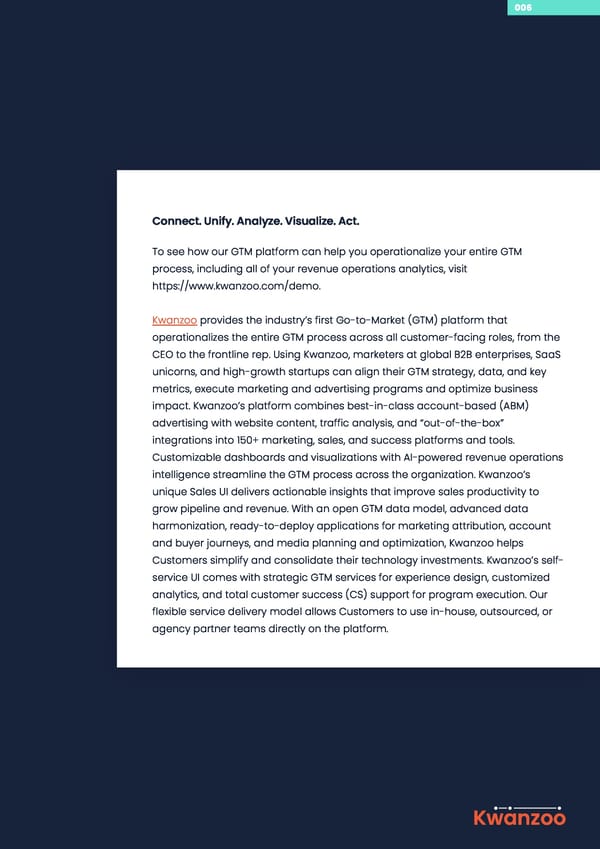1. How AI is transforming marketing
Kwanzoo How AI is Transforming Marketing Making the Impossible Possible KK

001 Chapter 1 The New Mandate: Growth Where Technology Makes the Difference Connecting to Data with AI in a Post-API World Chapter 2 Harmonizing Your Data with AI Making Smarter, Faster Decisions with AI-Assisted Insights Introduction Staying Sentinel Connect. Unify. Analyze. Visualize. Act. Rise of the Revenue Operations Machine The B2B buyer’s journey is growing increasingly complex. At the same time, marketing is getting a bigger seat at the executive table with record-high technology budgets that are expected to surpass those of CIOs this year. To top off this added complexity and growing accountability, buzzed-about advances in data analytics have stakeholders assuming marketing can seamlessly report on the evolving landscape in which they operate. Yet many digital marketers and their leadership remain in the dark. Even as the B2B buyer’s journey and overall B2B purchase lifecycle grows more complex, the processes used to connect, harmonize, & analyze sales, marketing and customer success data is extremely challenging. Bigger budgets and more sophisticated buyers mean more marketing technologies and tools within marketing stacks. This in turn means more diverse data sources in more formats to integrate — today, next month, and for the foreseeable future. Data and analytics are a mainstay, and marketers must look to new technological breakthroughs to make these processes as fluid and scalable as possible. Few technological advances complement revenue operations as well as artificial intelligence (AI) and machine learning. Playing a key role in everything from data integration, kpi calculation, to insight generation, AI enables revenue operations to scale while never missing an insight. Robotic Process Adoption In the last few years, AI and marketing-based analytic data models have made it possible to do things that marketers have talked about for decades. This conversation has become reality thanks to on-demand computing power, increasingly connected users, and advances in AI. That means marketers can drive better marketing performance across the entire B2B buyer’s Journey while understanding Impact and ROI properly for the first time. This paper discusses how AI is enabling the future of B2B Go-to-Market Kwanzoo
002 Chapter 1: The New Mandate Growth Ultimately, AI will support the new mandate: driving growth. But what does growth look like? Essentially, it breaks into three main goals: Performance: Optimizing performance across every tactic, campaign, channel, audience segment, product line, and market Impact: Connecting marketing performance with sales and revenue across new and existing customers Lifecycle: Improving customer experiences across the entire customer journey Keeping in mind these new expectations is key to understanding the significant impact AI will have. Where Technology Makes the Difference AI and machine learning are extremely complementary to B2B Revenue Operations because of the efficiency and adaptability they lend to your analytics and reporting system. This is especially apparent when it comes to prioritizing the various optimizations of your marketing, sales and success efforts. If there’s been one constant in marketing, sales and customer success (otherwise known as revenue operations) it has been rapid change. The ability of a system to improve its intelligence by leveraging crowd-sourced knowledge provides rev-ops teams with real benefits, including: Rapid time to value in connecting and unifying data from disparate sources Automating and future-proofing data models for scale and maturity Shrinking optimization cycles into hourly and daily windows instead of weeks Providing a single source of truth and direction for all customer facing teams Connecting to Data with AI in a Post-API World According to the latest Chiefmartec MarTech Landscape, there are over 5,000 different solutions available to marketers today — all of which generate data and insights. From these, marketers pick the combinations that help them manage campaigns and engagement data on a daily basis. With this amount of diversity, B2B marketers in particular quickly encounter the limitations of using APIs exclusively when it comes to connecting and aligning their data and rolling it up to the account level. (If you’re new to the API concept, in data analysis these are the protocols in technology platforms that allow you to pull data out.) Kwanzoo

003 UltimaUltimatelytely, AI w, AI will suppoill support the nert the new w ” mandamandate: Drite: Driving Gving Grroowth.wth. Connecting to Data with AI in a Post-API World (cont.) The first issue is that even among tools that offer a library of API connectors, it’s quickly becoming impossible to stay abreast of every one of the thousands of marketing platforms available. Secondly, when tools offer APIs for bringing data into other platforms, the fields available are often limited or even deprecated as API upkeep happens at a slower rate than the development of the platform itself. And lastly, there are many data sources without APIs or those that sit in files, databases, or big data stores (not to mention offline data). The API-only method is failing to hold up in the rising tide of marketing data platforms. In the pre-AI world, your only option would be to build and maintain custom APIs. Whether attempted in- house or via a services partner, the custom API path quickly becomes overwhelming, time-consuming, and expensive as the requirement to stay ahead of updates translates into project cycles with no endpoint. AI can transport you to a “post-API” world of unified revenue operations intelligence, where any data source you need can be added to the picture immediately — and by the marketing organization itself. To get this done, AI-powered data integration turns any data- reporting source in the form of a feed or file into a continuous data connection that leverages email, FTP, or other storage locations such as S3 buckets from Amazon Web Services (AWS) to maintain continual updates. A B2B focused AI acts like the human eye, recognizing what these sources are and how they should be mapped into a data model automatically by looking at the file input. Without this crucial function, data connections will often break, requiring the expertise of data scientists or external services teams to fix. AI can assist marketers by being a foundational layer on which to build a panoramic view of all your buyer touch points across their entire journey and rolled up to the account or line-of-business or division level. Using AI to augment data integration can effectively replace the spreadsheets, reports, one-off dashboards, or multiple systems previously needed to get a holistic view of marketing. This makes a formerly impossible task of integrating any new data in minutes — by marketers themselves — possible. Day to day, this means you can easily start reporting on your newest campaigns immediately, switch out platform A for platform B in your stack without a hitch, or bring a new data source into the mix to answer a deeper question — all at the speed of marketing. Kwanzoo
004 Chapter 2: Harmonizing Your Data with AI Centralizing data is step one, and step two, which has been a gap for B2B rev-ops teams, is getting it organized and aligned at the account level, particularly when harmonizing programmatic media. But with data coming from many different sources and platforms — this doesn’t just happen on its own. It takes the process of data harmonization through a data model to get every performance, outcome, and investment talking together. At marketing’s scale, this can sound daunting — and without the right approach it is, and worse; at scale it can grow impossible. With AI, it’s possible for B2B data to self-organize for you. When you need to measure and monitor business goals and compare and contrast performances, you want your data from all of its different sources to line up by region, product, or the teams you support. On the marketing side, you want to be able to drill down from the highest level of each ROI, growth, or loyalty KPI, to every level beneath it. And you need to be able to do this across programs, campaigns, channels, content, audience, and customer segments. Before AI-assisted marketing, creating data models to enable this would require vast time and expertise. It would take continuous investments to build models from the ground up, relationship by relationship, within the data. But within marketing data, the relationships are complex and numerous to begin with across channels, campaigns, media buys, landing pages, and conversion points — and they change as marketing evolves and redesigns its approach over time. The new approach is to use dynamic B2B data models that continually expand their knowledge from across customers to provide expert-in-the-box understanding of how marketing data should be related. Paired with AI and machine learning, integrated data can be automatically mapped into the model with no need to create or maintain a model from scratch. Together with centralizing data, these AI and machine learning applications dramatically improve initial time to value as well as provide ongoing agility as marketing’s data continually changes and scales. As they scale, they make it possible for marketers to get the best of both worlds — total organization and total flexibility — to continually evolve their models with no projects, advanced skills sets, or even downtime. This becomes not just a nice-to-have, but a need-to-have as your marketing evolves and your intelligence efforts span to new teams and regions with success. Looking ahead to the next step, they’re also the essential building blocks of moving to AI-powered always-on optimization across all your data. Kwanzoo
005 Making Smarter, Faster Decisions with AI-Assisted Insights AI-assisted insights is the latest modern application of AI that works on behalf of marketers to elevate information that supports better decision-making. While this has been called the next wave over the past few years, it’s here now — and it’s powerful. Whether the marketing budget is $1 million or $100 million a year, CMOs in central roles within the business are being asked to make performance and results more predictable. Outputs have much wider visibility, and peers are counting on marketing to deliver But in order to meet goals, smarter decisions need to happen on a more frequent basis — across the entire customer journey. The sheer scale of data in a pre-AI world has limited marketers’ ability to see opportunities and take action. But it stands to reason that if results need to be predictable, marketers need a pipeline of insights to become more predictable as well. It should be as easy to get new ideas on improving marketing as it is to browse a feed of stories on your favorite social networks. This is where AI is entering now. Across the millions or billions of rows of data marketers are expected to make sense of, AI bots are being released to find not only what’s moving and shaking in their performance, but also answering why it’s happening and what they can do about it. These are the optimization paths CMOs and their teams can use to flip that switch to always-on optimization. If dashboards help answer the questions you have already, AI helps you know what you don’t know. This introduces a new way to collaborate with your marketing technology. You provide an agenda composed of the KPIs you want to watch on an ongoing basis, and off goes your “assistant” into your data. Now, millions of data points get analyzed on a continual basis to tell you what’s driving KPI performance, in a prioritized order of impact. You might want to stay fixated on channel or campaign marketing ROI, campaign engagement or conversion rate, or campaign CPM or CTR rather than focus on the labor-intensive, manual effort of data integration and alignment that will ultimately cause you to miss critical findings in your ever-expanding dataset. Imagine a marketing world where your KPI performance could be better understood via intelligent insights that help you learn what’s actually driving your KPI performance up or down. That way you know exactly which campaigns and similar attributes are the root drivers of your marketing ROI and which are pulling it down. From executives to campaign managers and analysts, there are answers in your data that can help you hit your goals through better curated information each day. The challenge is surfacing them in time to activate them. With AI, marketers can leave less opportunity on the table — at scales and speeds that previously couldn’t be accomplished through manual analysis. Staying Sentinel AI isn’t replacing creativity or human decision-making. But it can play the role of sentinel, working tirelessly to ensure you never miss a beat. Marketing is getting a bigger seat at the executive table. This means more accountability, and more potential for impact. Marketing as a practice is changing, as rapidly and constantly as the buyer journey. AI and machine learning are rising to meet the challenges of modern marketing, providing an adaptability and ability to scale that saves marketers time — and makes them smarter. So where do AI and machine learning fit in marketing? The answer is at every step of the process. Kwanzoo
006 Connect. Unify. Analyze. Visualize. Act. To see how our GTM platform can help you operationalize your entire GTM process, including all of your revenue operations analytics, visit https://www.kwanzoo.com/demo. Kwanzoo provides the industry’s first Go-to-Market (GTM) platform that operationalizes the entire GTM process across all customer-facing roles, from the CEO to the frontline rep. Using Kwanzoo, marketers at global B2B enterprises, SaaS unicorns, and high-growth startups can align their GTM strategy, data, and key metrics, execute marketing and advertising programs and optimize business impact. Kwanzoo’s platform combines best-in-class account-based (ABM) advertising with website content, traffic analysis, and “out-of-the-box” integrations into 150+ marketing, sales, and success platforms and tools. Customizable dashboards and visualizations with AI-powered revenue operations intelligence streamline the GTM process across the organization. Kwanzoo’s unique Sales UI delivers actionable insights that improve sales productivity to grow pipeline and revenue. With an open GTM data model, advanced data harmonization, ready-to-deploy applications for marketing attribution, account and buyer journeys, and media planning and optimization, Kwanzoo helps Customers simplify and consolidate their technology investments. Kwanzoo’s self- service UI comes with strategic GTM services for experience design, customized analytics, and total customer success (CS) support for program execution. Our flexible service delivery model allows Customers to use in-house, outsourced, or agency partner teams directly on the platform. Kwanzoo


